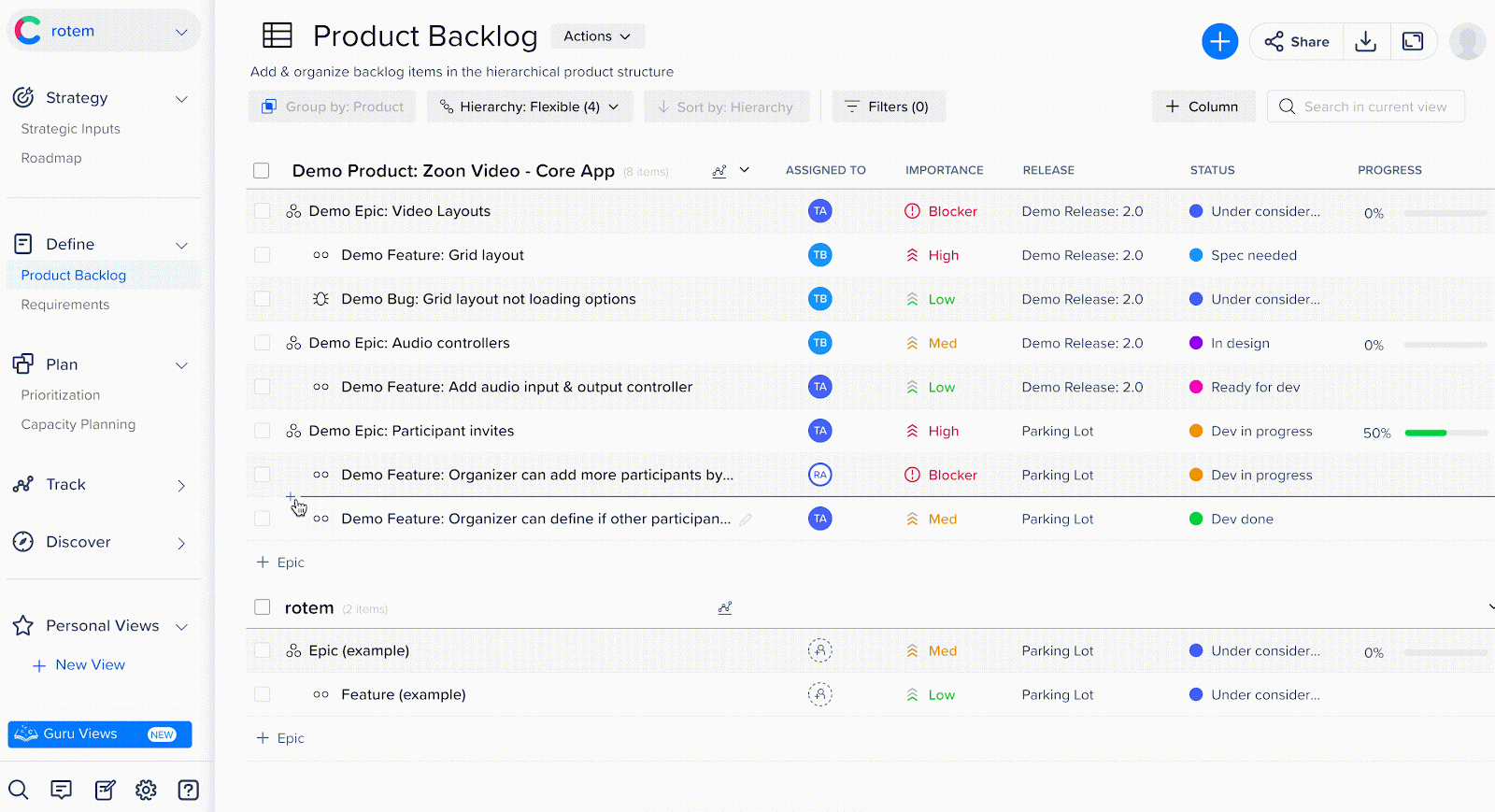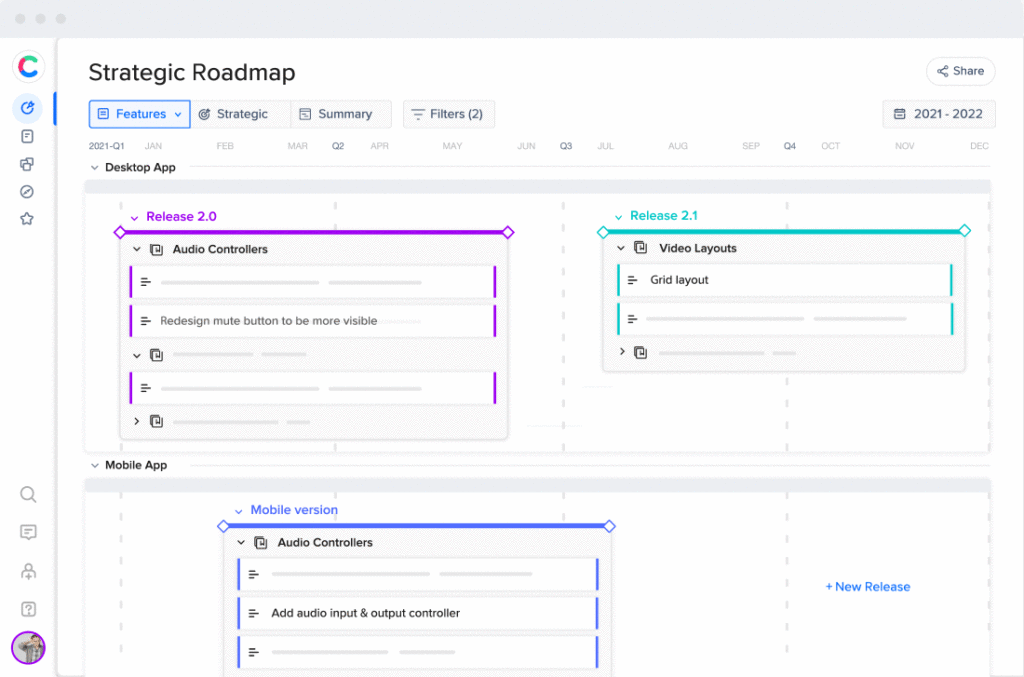Home > Blog > 7 Product Roadmapping Mistakes and How to Avoid Them
7 Product Roadmapping Mistakes and How to Avoid Them

A properly developed and shared product roadmap can add massive value to an organization — and provide a big boost to the product’s chances for success. When built and shared the right way, a roadmap can align key participants across the company around a shared set of goals and plans. It can build stakeholder enthusiasm for the product. And it can help ensure everyone is steering in the same strategic direction.
But roadmapping is a challenging process. Product Managers often fall into one or more of the many pitfalls that can undermine a roadmap’s strategic value. In this post, we’ll review seven product roadmapping mistakes and offer you suggestions to avoid them.
1. Focusing on outputs over outcomes
One of the most common roadmapping mistakes we’ve observed over the years is Product Managers using the roadmap to explain what they’re hoping to complete (the outputs) and not why they believe those items will add value (the outcomes).
Imagine your research reveals that the reason your B2B app is failing to connect with several key industries is that those industries are heavily regulated for data privacy, and your app doesn’t support compliance with those regulations. So, you prioritize adding security and compliance processes to the app.
Here’s where many Product Managers make an extremely common roadmapping mistake: They simply list those epics or features on the roadmap: “TLS 1.2 encryption,” “Earn HIPAA certification,” etc.
And when the product team shares this roadmap with key stakeholders, reading those words on the roadmap inspires exactly none of them. That’s because those are just outputs, not outcomes. Each of these commitments on the roadmap leaves the key question unanswered: “Why should we care about this?” In fact, it will probably prompt that question.
Here’s how a Mind the Product article summarizes the problem of sharing a roadmap without any goals:
“Your team might follow this roadmap and build the features, but they would be running based on instructions from a key stakeholder. It may result in them being demotivated to build a product intended to achieve something meaningful.”
What to do about it:
As you build your roadmap, make it a habit to include your strategic reasoning right alongside every item on the roadmap. For your “Earn HIPAA certification” initiative, for example, you can include a line right underneath that reads: “Will help us generate healthcare-industry leads.”
2. Failing to account for resource levels
Product roadmaps don’t exist in a vacuum. For every item that you include on your roadmap — particularly if you’re also going to include an estimated completion time frame — you’ll need to first make sure you have the teams, budget, and skill sets necessary to get the work done.
But unfortunately, many Product Managers build their roadmap first — before matching up their “wish list” of strategic items with the company’s available resources and the other projects that could be competing for the development team’s time.
Only after they’ve created this wish list will these Product Managers share it with their developers and ask if they have the capacity to complete the projects in the requested time frame.
This can create serious operational challenges. For example, it can delay the product team’s work, because they’ll have wasted whatever time they spent prioritizing and selecting items for the roadmap before checking with the development team about their capacity levels.
What to do about it:
A key product management best practice is to sync your capacity planning and roadmap prioritization into a single process. As you assign story points to a feature or epic you’d like to add to the roadmap, check your company’s capacity levels for the relevant timeline in real-time. Will you have the available resources? Will those developers be the right ones for this project — meaning do they have the right skills and knowledge to execute your strategic goals?
The most efficient and reliable way to sync your capacity planning and roadmap prioritization is to find a product management platform with this capability built in.
3. Presenting the roadmap as a promise
Another common roadmapping mistake is allowing stakeholders to view items listed on the product roadmap as a guarantee that they’ll be ready on the deadline associated with them. Product Managers can fall into this trap in a couple of ways:
- Including a specific due date for each item on the roadmap.
- Failing to clarify for stakeholders that the roadmap is simply a guiding strategic blueprint — a goal — and not a contract or a promise.
What to do about it:
To avoid this pitfall, we recommend a two-step best practice.
The first step involves your communication strategy. Whether you present your roadmap in a stakeholder meeting, or LiveShare the roadmap link with specific coworkers, you need to include clear language that the roadmap represents your current plan and goals — but that it could also change at any time for any number of reasons.
Step number two involves making sure you have the right tool for this job.
Anytime you plan to share your roadmap, you need to think through whether or not you want to share dates or time frames with these specific stakeholders. For one group — your developers, for example — you might want to show your goals for completion times, because they’ll need this information to prioritize their work and to determine if they have the capacity to get it done.
But when you’re sharing the roadmap with other audiences — for example, your sales team — you might want to leave the timelines off altogether. You don’t want an overly enthusiastic sales rep to copy the roadmap’s dates and share it with prospective customers.
The key to step number two is to make sure you have a roadmapping solution that lets you easily display or hide timelines depending on your audience.
4. Managing the roadmap as a glorified backlog
A product backlog is a list of ideas, suggestions, requests, and other items your team hopes or plans to work on — at some point in the future. It’s definitely not a best practice to allow your backlog list to become so large you have difficulty finding a specific item on it. But in theory, you could. There is no limiting principle on the size of a product backlog.
Your roadmap, by contrast, must be limited in scope, number of items included, and timeframe. The roadmap represents your strategic plans and goals over a coming period of time — from a few months to a year or more. You can’t work on every backlog item in that timeframe, nor should you want to.
Your product roadmap should include only the items you have already vetted, deemed strategically viable and worthy of your team’s time, and added to your company’s near- or mid-term agenda.
Where Product Managers often go wrong is by treating their roadmap as simply the top items on their product backlog. It’s easy to focus on those items, or the tactical requests people are asking for, and make progress on those. But that removes the strategic work you’ll need to make sure your team is using its limited time and resources to build the things that have the best chance of resonating with your market and generating revenue for your company.
What to do about it:
First, you’ll need to keep your backlog and roadmap separate. Items you haven’t yet vetted and prioritized go in the backlog. When you’ve prioritized an item and determined it’s worth pursuing, only then should you place it on the roadmap. And only after you’ve also determined you’ll have the resources to get the work done in the estimated timeline you’ve set for the project.
Ideally, your backlog will look like this:

And your roadmap will look something like this:

And again, the best practice is to make sure you have a comprehensive product management platform that lets you maintain both assets in one place — so you can quickly and easily review items in both documents and move them back and forth according to your strategic plans.
5. Treating the roadmap as “done” instead of adaptable
Another extremely prevalent roadmapping mistake is to create the product roadmap, share it with stakeholders, and then treat the plan as if it’s set in stone.
Inexperienced Product Managers often fall into this trap because they perceive having to course-correct in the middle of development as a failure. And that’s because they’re simultaneously making other mistakes on this list — including treating their roadmap as a promise and focusing on outputs instead of outcomes.
In reality, very few products go from concept to roadmap to market launch according to the exact plan initially laid out by the Product Manager. External conditions will almost always evolve at some point during the development process. Company resource levels change, priorities shift, budgets get pulled from one project for another, etc.
Your goal should be to build and release a product that resonates with your market — not to prove that you can keep everyone on track with your original strategic plan, especially if changing circumstances mean it’s no longer the most likely path to product success.
What to do about it:
Our recommendation here is to embrace the fact that your roadmap will almost certainly change over the course of your product development — and to accept that this is okay. Being agile and adaptable to changing circumstances improves the chances that the product you release will be the right one for your market’s needs.
6. Building the roadmap as a static file
Another common reason Product Managers fail to update and adapt their roadmaps is simply that doing so would be a tedious, time-consuming task — because they created the roadmap using the wrong application.
When Product Managers develop their roadmaps as spreadsheets or presentation slides, they need to manually update those files every time something changes in their strategic plans. Even more frustrating, they might need to manually recreate the entire roadmap every time they want to share it with a different group of stakeholders who will want to focus on different details of the plan.
Petra Angeli is Vice President of Products for craft.io customer Acolad, one of the world’s largest providers of technology-enabled language services. As Petra explains:
“I don’t want my team to be inefficient, having to recreate product-related information over and over again to be able to show it in different ways for our different stakeholders. So why would we spend time building these views in PowerPoint, getting everything just right, only to do it all over for another audience? And why would we want to build any roadmap manually in the first place, knowing some portion of what we just created might become outdated shortly after?”
Building a roadmap in a static document wastes hours of your time. It can also make updating the roadmap such a dreaded hassle that Product Managers simply won’t do it — even if that’s what the changing conditions require.
What to do about it:
This is an easy fix. Thankfully, you don’t need to keep building (and painstakingly updating) your roadmaps using the wrong software tools.
craft.io has built an end-to-end product management platform designed to make viewing, adding, changing, displaying, hiding, and adjusting roadmap content easier than it’s ever been.
7. Failing to prioritize based on feedback
The final roadmapping pitfall we want to highlight could be the most serious mistake of all, because it means the team is making strategic decisions about what to build without the invaluable benefit of its users’ input.
Whatever decision criteria your product team uses to select one item over another for development, and whichever prioritization framework you choose to weigh competing items, one metric that should always factor into your decisions is user feedback.
One of the most common reasons we’ve heard for why Product teams don’t maintain active, easy-to-view feedback — feature requests, favorite aspects of the product, user-experience complaints, etc. — is that they don’t have a mechanism for collecting and analyzing this data.
What to do about it:
More good news: If centralized, actionable user feedback is lacking at your organization, this is another easy fix. craft.io’s end-to-end product management platform includes a highly intuitive feedback portal — with built-in scoring and prioritization, the ability to pull in feedback from other apps, and even best-practice questions and prompts to help you get started encouraging feedback from users.
Make your roadmapping process intuitive and simple
Creating and sharing your product roadmaps effectively can be a difficult balancing act. You’ll want to share just the right level of detail with each stakeholder audience, adjust your roadmap plans as needed, manage stakeholders’ expectations, etc. Successfully achieving all these objectives — while keeping everyone informed on the latest strategic plans for your products — will always be a challenge. That’s built into the role of a Product Manager.
But you can mitigate many of these challenges by following the best practices we’ve outlined above. And you’ll make your roadmaps even more effective — and your life even easier — by making sure you’re using the right tool for product roadmapping.


